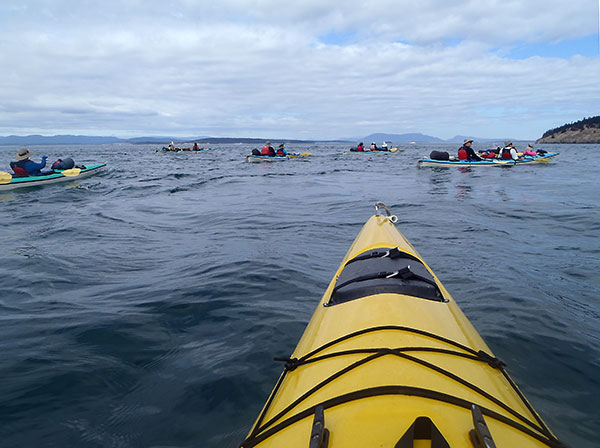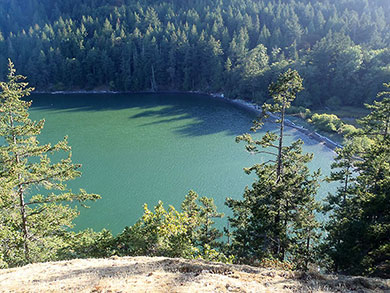
Killer whale's tail photo by Diana Hunt
Years ago, while traveling on a ferry in the San Juan Islands, I heard the captain make an announcement that a pod of orcas, better known as killer whales, were alongside the ferry. My family and I scurried to watch. Fascinating. I promised then and there that I'd return another time for a longer look.

Heading out for a kayak adventure
It took longer than I'd planned, but I did return. This time I was part of group of sea kayakers. The timing for sighting killer whales was favorable and the odds were good. 70 percent of the people who'd made two-day paddles with this particular outfitter had sighted orcas.
From Friday Harbor, our small armada of kayaks and kayakers had been shuttled across San Juan Island to Smallpox Bay, where we hauled our boats from the trailers to the launch site. Our two guides loaded their single-person kayaks while the rest of us placed our personal and shared gear - things like stoves, food boxes, tents and sleeping bags - into double- and triple-seat kayaks.
We prepare in Smallpox Bay for our overnight sea kayak journey.
Smallpox Bay at San Juan County Park is so named because it is a place where Native Americans dove into the bay's frigid waters in attempts to cool their fevers. Many drowned, died of hypothermia or the disease. By the time Europeans were actively colonizing San Juan and neighboring islands, most of the native population was decimated. Before it was colonized, what is now San Juan County Park was for hundreds of years a native campground during the summer salmon migration.
But salmon weren't in our plans. Our goal was to paddle within viewing range of orcas, which inhabit the waters of the San Juan Islands west of Anacortes, Washington. Mid-July to mid-October are the peak times for seeing orcas, according to Sea Quest Expeditions. Three pods of more than 90 orcas are San Juan Islands residents, a decline from numbers reported 40 years ago. Adult males, which are larger and heavier than females, are often 20 to 26 feet long and weigh about four tons. With their black backs, white chests and sides, plus a distinct white patch above and behind their eyes, orcas are easy to identify. Orcas are often seen breaching, sometimes lifting their entire bodies out of the water.
Like the others, I hoped to get up close and personal in a kayak.
Sailboats and ferries were awesome sights from our low water level.
It didn't happen. Over the next two days our group paddled 11 miles to Stuart Island, where we camped overnight, then paddlled 11 miles back to Smallpox Bay. We saw no orcas, but it's impossible not to enjoy and appreciate the many other attractions - Dall's porpoises, bald eagles, common murres, double-breasted cormorants and harbor seals along with a brigade of ferries, yachts and huge cargo ships - visible from water level.

Follow the leader, kayak style
Kayaking at sea is different than paddling a river or lake. Tides, currents and winds make it more challenging. Paddling with others also requires synchronization. The front paddler sets the pace while the person in the rear uses foot pedals to steer the boat. Easily recognizable were "paddle pals" who had obviously kayaked before. They quickly, quietly and harmoniously cruised along, their two-bladed paddles perfectly coordinated, their direction straight and efficient. We were divided into two- and three-person kayaks while our guides, Elizabeth Robinson and Mariana Malki, were in single-person boats.

View from the front
We paddled north alongside and past San Juan Island's western shore, eventually crossing open waters to Henry Island, where we beached our boats for a shore-side lunch. After eating we continued on, sometimes sitting back and savoring the scenic, calm waters along Haro Strait. We crossed the Spieden Channel and, by later afternoon, worked our way to Reid Harbor on Stuart Island.
There are more than 400 islands, depending on tides, with 150 named islands. Ferry boats access only four - San Juan, Shaw, Lopez and Orcas - but not Stuart.

Ready to eat
Before dinner, Elizabeth and Mariana told us tidbits about the islands history. San Juan Island, which was jointly occupied by United States and Canada because of a years-long boundary dispute, was the site of the 1859 Pig War. After an American farmer shot and killed a pig owned by an Irishman, military build-ups began. By August 10, 1859, 461 Americans with 14 cannon under Colonel Silas Casey were opposed by five British warships mounting 70 guns and carrying 2,140 men.
The governor of the Colony of Vancouver Island ordered British Rear Admiral Robert L. Baynes to land marines on San Juan Island and engage the American soldiers. Baynes refused, deciding that "two great nations in a war over a squabble about a pig" was foolish. Commanding officers on both sides were told to defend themselves but directed not to fire the first shot. For days British and U.S. soldiers exchanged insults, each side attempting to goad the other into firing first, but no shots were fired. The dispute was eventually resolved by an international arbitration commission in Geneva, Switzerland.
| |
 |
|
 |
|
| |
View from the trail |
|
Stuart Island library |
|
When Elizabeth and Mariana finished our history lesson and fixed dinner, most of us ventured off. I followed a trail that climbs above the campground to overlooks of the harbor and its fleet of expensive sailboats. On the way back, along the shore were several beached moon jellyfish and lion's man jellyfish. Some were transparent, some glowed with reddish hues while others were the color of egg yolks. But the biggest surprise was the campground restroom, a one-holer. Inside, on a shelf, were paperback books and a sign announcing, "Stuart Island Public Library: Take a Book, Leave a Book." There weren't many offerings, but they did range from Fyodor Dostoevsky to John Grisham to Emily Bronte.
| |
 |
|
 |
|
| |
Leaving Stuart Island |
|
Taking a break |
|
Early the next morning, in order to take advantage of favorable tides, we ate an early breakfast - toad in a hole (a fried egg cooked in a hole in a piece of bread), broke camp and loaded our kayaks for a 7 o'clock departure. The return route varied slightly, sliding past Johns Island, curling along the western tip of Spieden Island and re-crossing Spieden Channel. We paddled past a pelagic cormorant rookery before again passing alongside Henry Island and hugging San Juan Island's shore south back to Smallpox Bay.

We paddlled along island cliffs in late afternoon, then rode the ferry from Friday Harbor
back to Anacortes.
It was time to swap paddle power for a motorized ride.
The ferry hadn't gone far when,
whad'ya know, a pod of orcas did a distant watery dance.

We paddlled back to our starting point.
When you go
My San Juan Islands kayak paddle trip was booked with Sea Quest Expeditions. San Juan Island tours include morning, afternoon, sunset tours, women's only tours, and two-, three- and five-day tours. For information visit their website at www.sea-quest-kayak.com or call 888-731-7426.

Lee's wooden orca carving
About the author
Lee Juillerat is a freelance writer-photographer. In addition to doing stories for newspapers in Southern Oregon, he is a frequent contributor to several magazines. Lee is the author of books about Crater Lake National Park and, most recently, Lava Beds National Monument. He has written about his travels and adventures on five continents for High On Adventure for more than 30 years. Lee can be contacted at 337lee337@charter.net.
|